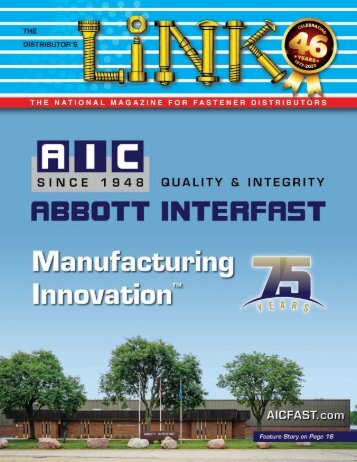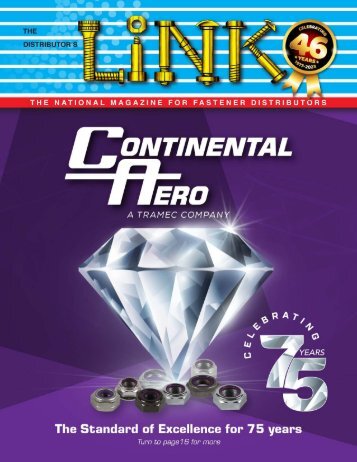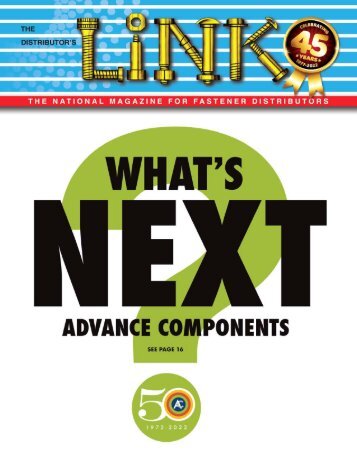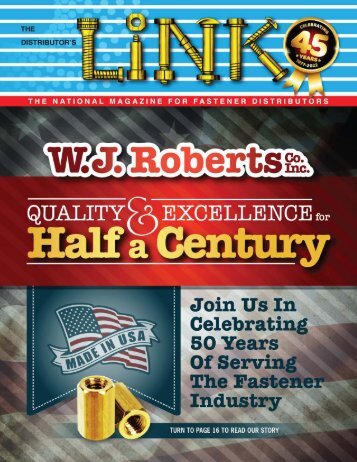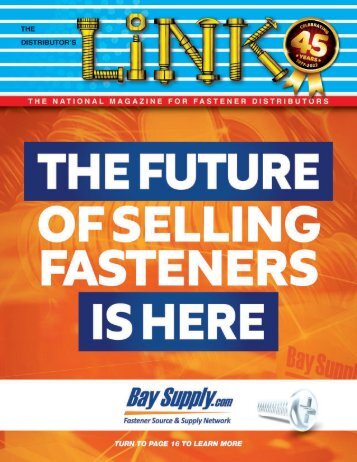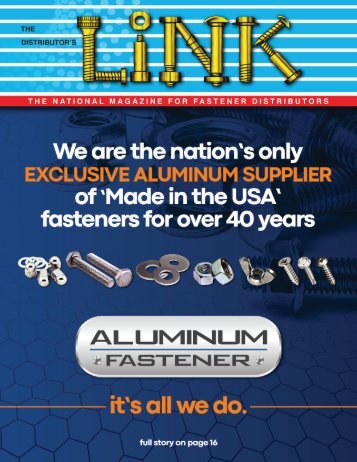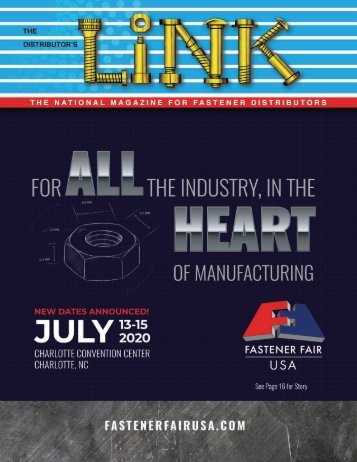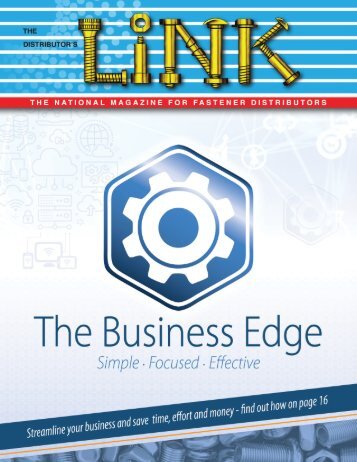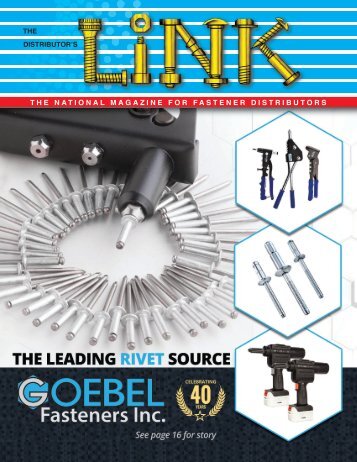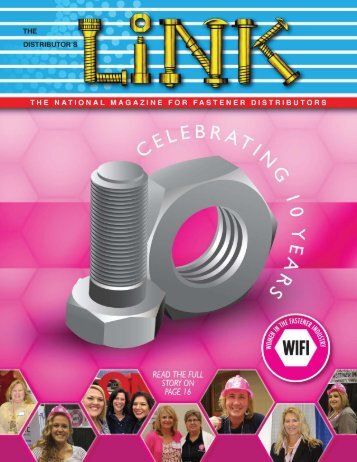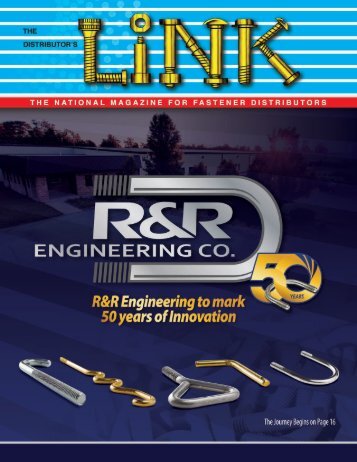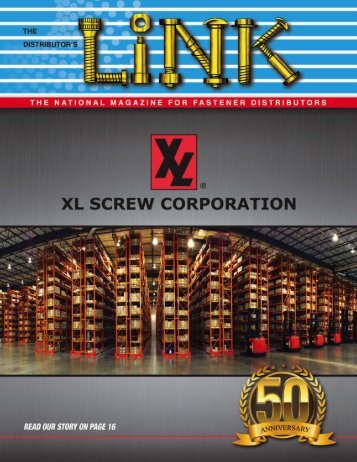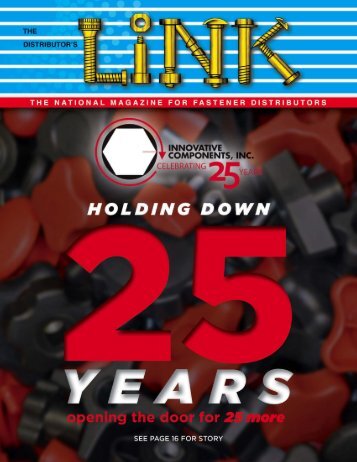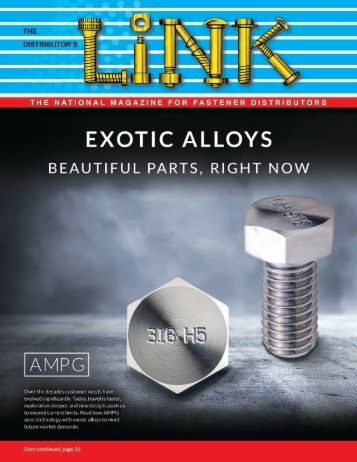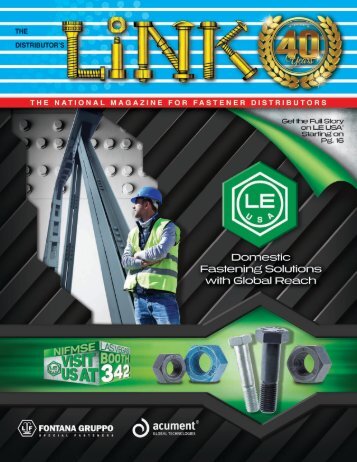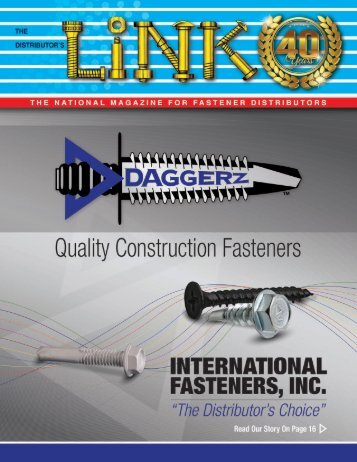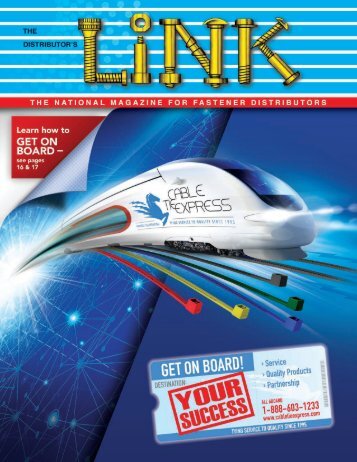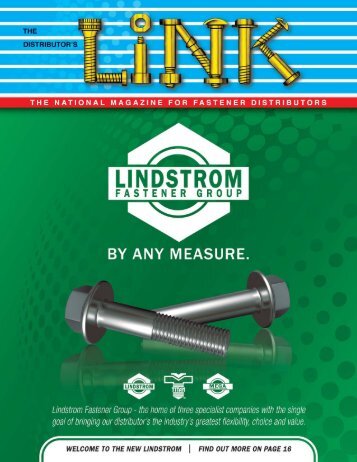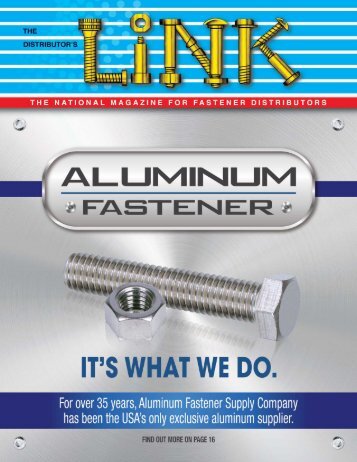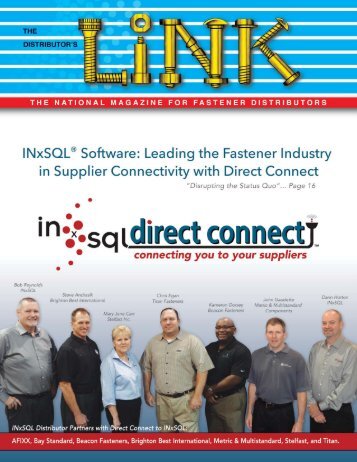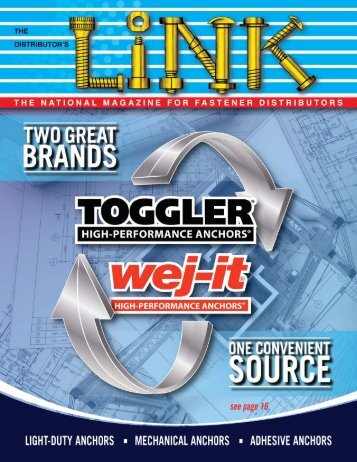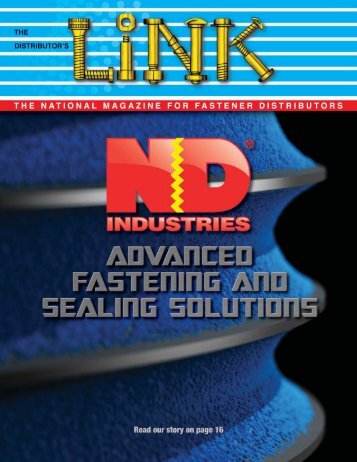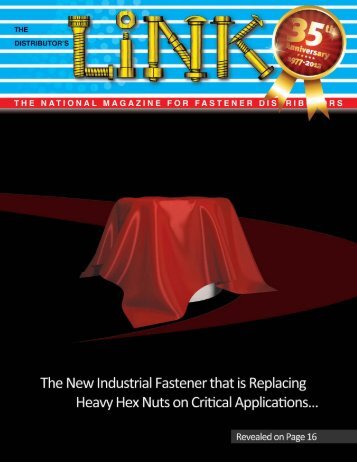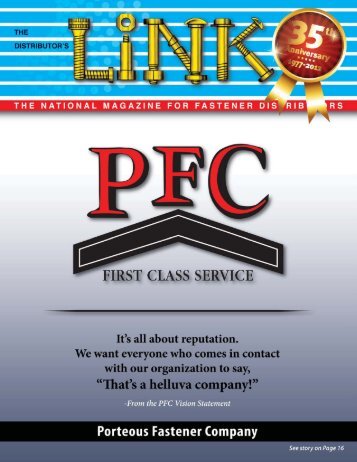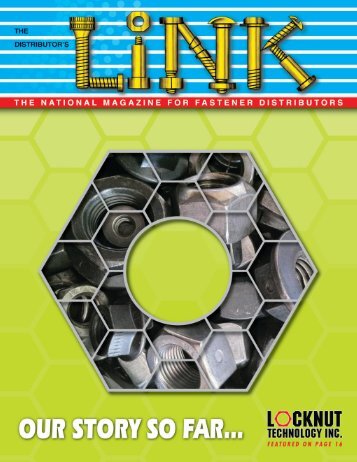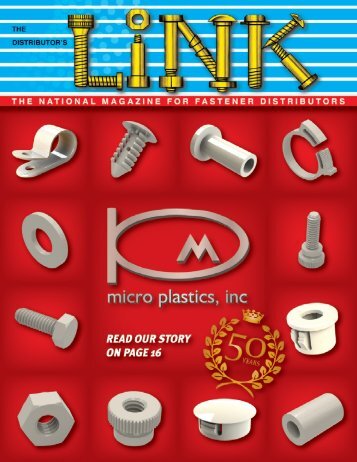SPRING 2021
- Text
- Engineering
- Products
- Association
- Components
- Screws
- Manufacturing
- Stainless
- Bolt
- Fasteners
- Fastener
162 THE DISTRIBUTOR’S
162 THE DISTRIBUTOR’S LINK LAURENCE CLAUS A “GALLING DEVELOPMENT”- WHAT EVERY DISTRIBUTOR SHOULD KNOW ABOUT THREAD GALLING from page 142 A strong warning, however, must be raised related to Cadmium plated fasteners. Almost thirty years ago Cadmium was identified as being both unfriendly to the environment and human health, and, is, therefore, banned from many industrial applications. Even in those industries where Cadmium is still commonly used, recent trends are all moving in the direction to eliminate it. ¤ Hard Chrome – creates a very hard, wear resistant surface that can be applied to both carbon and stainless steels. ¤ Xylan ® - A Teflon® (PTFE) based coating similar to what is applied to non-stick cookware. ¤ Tin [5] – has natural lubricity and “smears” rather than cracks Material Choice If galling is a problem, one possible fix is to vary the bolt and nut material. Using components of the same material may foster like-to-like interactions and more easily promote adhesion than if the materials were different types. Additionally, pairing different stainless steel materials with one another may reduce galling because the hardness and work hardening rates are different. For example, pairing a 304 stainless component with a 316 stainless component could be beneficial. One must be careful if taking this approach, however, because not all stainless steels provide the same properties or hold up equally in certain environments. It would be unfortunate to solve one problem only to replace it with a more serious one. Thread Pitch Thread Pitch is the distance from the point on one thread to the same point on the adjacent thread. Thread Pitch instructs us about the spacing between threads which usually fall into either coarse or fine categories. Fine threads have closer spacing, which provides some advantages like increased strength, finer adjustability, and less inclination to self-loosen, but they also are more prone to nicking and galling. If galling is a high concern, it is generally recommended that designers and users avoid fine threads. Thread Damage Nicks and dings in threads are a strong trigger for galling. These imperfections, even minor ones, increase the torque required to assemble the fastener, which likewise increases friction and heat generation. Nicks may act like the lumps on a part that is already galled and locally damage the protective oxide layers, thus triggering the beginning of galling in those areas. Fine threads are more prone to thread nicking than coarse threads, yet neither are immune. Cutting tools used to produce cut threads may become worn or damaged and result in rougher surfaces. Debris In Thread In a similar vein as thread nicks, threads that have entrapped debris such as dirt, metal fines, or slivers, are more likely to trigger galling than clean threads. Dirty threads may also impact other processes like adding variability to the method of tightening control, so that best practice encourages the use of clean threads. Thread Engagement In general, standard bolt and nut joints and blind nut joints limit the number of engaged threads. Likewise, nut and bolt joints are designed, when possible, to limit the threads of the bolt protruding beyond the top of the nut to about two pitches. When following such design parameters, the number of engaged threads and the number of threads which must pass through the joint is limited. This is advantageous because excessive thread engagement causes increased interference and friction. Screw threads, like any other manufactured element, cannot all be manufactured exactly alike. Thus as you compare one thread to the next and the next, on down the line, small variations in size and geometry appear. On their own, these minute variations raise little concern, but they are additive in nature, so that when taken as the whole, the engagement of each subsequent thread results in greater amounts of thread fit error that often translates into increasing interference and friction. Thus, increased thread engagement or the number of threads run through a nut can trigger galling. CONTINUED ON PAGE 164
THE DISTRIBUTOR’S LINK 163 Semblex Corporation and its parent company, Jinhap Company, Ltd. have announced the following management changes effective May 1, 2021. Jinsoo Kim, the current president of Semblex has been promoted to lead the international businesses of Jinhap and oversee operations outside of Korea, which include Jinhap companies in China and Semblex in the United States. He will be relocating to Korea later this year. Mr. Kim has been at Semblex since it was acquired by Jinhap in 2014 and has served Semblex as Chief Operating Officer and, most recently, as CEO and company president since March 2019. Gene Simpson, currently serviing as Semblex’s Chief Operating Officer, has been promoted to replace Mr. Kim as CEO and company president. Prior to his COO role, Mr. Simpson served in a number of key management positions at Semblex over the last 29 years, including Vice President of Quality & Engineering and Director of Engineering Services. Semblex Corporation, established in 1968, is a premier supplier of innovative cold-formed product solutions to the world’s leading manufacturers that look to significantly reduce their assemblyrelated costs, or are challenged to find the best way to fasten new materials emerging in their industries. Semblex provides customers with the latest fastening technologies, along with precision coldformed and machined components, and special assemblies For more information, contact Semblex Corporation at 900 North Church Road, Elmhurst, IL 60126. Tel: 1-800-323-1736, Fax: 630-530- 8189, Email: sales@semblex.com or visit their website at www.semblex.com.
- Page 6 and 7:
in the Spring 2021 issue of 6 DISTR
- Page 8:
6 THE DISTRIBUTOR’S LINK Dermott
- Page 12:
10 THE DISTRIBUTOR’S LINK Laurenc
- Page 16:
14 THE DISTRIBUTOR’S LINK Salim B
- Page 28:
26 THE DISTRIBUTOR’S LINK Guy Ave
- Page 32:
30 THE DISTRIBUTOR’S LINK Larry B
- Page 36:
34 THE DISTRIBUTOR’S LINK SPECIAL
- Page 39 and 40:
THE DISTRIBUTOR’S LINK 37 PACIFIC
- Page 41 and 42:
The Auto Bolt Company is proud to a
- Page 46 and 47:
44 THE DISTRIBUTOR’S LINK Anthony
- Page 48:
46 THE DISTRIBUTOR’S LINK COMPONE
- Page 51 and 52:
THE DISTRIBUTOR’S LINK 49
- Page 54:
52 THE DISTRIBUTOR’S LINK Nelson
- Page 57 and 58:
THE DISTRIBUTOR’S LINK 55 GOEBEL
- Page 59 and 60:
Jay-Cee Sales and Rivet Inc., a Mas
- Page 61 and 62:
THE DISTRIBUTOR’S LINK 59
- Page 64:
62 THE DISTRIBUTOR’S LINK MID-ATL
- Page 69 and 70:
INTERNATIONAL FASTENERS, INC. THE D
- Page 71 and 72:
THE DISTRIBUTOR’S LINK 69 ROMAN B
- Page 76 and 77:
74 THE DISTRIBUTOR’S LINK WOMEN I
- Page 78:
76 THE DISTRIBUTOR’S LINK PIVOT P
- Page 82:
80 THE DISTRIBUTOR’S LINK NORTH C
- Page 85 and 86:
THE DISTRIBUTOR’S LINK 83
- Page 88:
86 THE DISTRIBUTOR’S LINK NATIONA
- Page 91 and 92:
THE DISTRIBUTOR’S LINK 89 ABLE LA
- Page 93 and 94:
THE DISTRIBUTOR’S LINK 91
- Page 96 and 97:
94 THE DISTRIBUTOR’S LINK SPIROL
- Page 98:
CONTINUED ON PAGE 156
- Page 101 and 102:
UC COMPONENTS, INC. 18700 Adams Cou
- Page 104 and 105:
102 THE DISTRIBUTOR’S LINK SALIM
- Page 106 and 107:
104 THE DISTRIBUTOR’S LINK JOE DY
- Page 108 and 109:
106 THE DISTRIBUTOR’S LINK NEW EN
- Page 110 and 111:
108 THE DISTRIBUTOR’S LINK GUY AV
- Page 112: 110 THE DISTRIBUTOR’S LINK PENN E
- Page 115 and 116: SEMS AND SPECIALS INC OUR EMPLOYEES
- Page 118 and 119: 116 THE DISTRIBUTOR’S LINK JIM TR
- Page 120: 118 THE DISTRIBUTOR’S LINK SOUTHW
- Page 124 and 125: 122 THE DISTRIBUTOR’S LINK COMPON
- Page 126 and 127: 124 THE DISTRIBUTOR’S LINK MWFA P
- Page 128: 126 THE DISTRIBUTOR’S LINK NELSON
- Page 132 and 133: 130 THE DISTRIBUTOR’S LINK ROBERT
- Page 136 and 137: fastenerlinks THE DEFINITIVE WEB DI
- Page 138 and 139: fastenerlinks BRINGING YOU THE FAST
- Page 140 and 141: fastenerlinks BRINGING YOU THE FAST
- Page 142 and 143: 140 THE DISTRIBUTOR’S LINK BRUNO
- Page 144: 142 THE DISTRIBUTOR’S LINK LAUREN
- Page 148 and 149: 146 THE DISTRIBUTOR’S LINK GUY AV
- Page 150 and 151: 148 THE DISTRIBUTOR’S LINK LARRY
- Page 152: 150 THE DISTRIBUTOR’S LINK COMPUT
- Page 155 and 156: THE DISTRIBUTOR’S LINK 153
- Page 157: THE DISTRIBUTOR’S LINK 155 ROBERT
- Page 161 and 162: THE DISTRIBUTOR’S LINK 159 BRUNO
- Page 166 and 167: 164 THE DISTRIBUTOR’S LINK LAUREN
- Page 168 and 169: 166 THE DISTRIBUTOR’S LINK John R
- Page 170 and 171: 168 THE DISTRIBUTOR’S LINK JOHN G
- Page 172: 170 THE DISTRIBUTOR’S LINK Thread
- Page 176: advertisers index F FORD FASTENERS,
Inappropriate
Loading...
Mail this publication
Loading...
Embed
Loading...
|
SHARE A PAGE FROM THIS MAGAZINE OPTION 1: Click on the share tab above, or OPTION 2: Click on the icon (far right of toolbar) and then click on the icon (far right of toolbar) and then click on the  icon (top right of the page). icon (top right of the page).
|
View Archives
Copyright © Distributor's Link, Inc. All Rights Reserved | Privacy Policy








